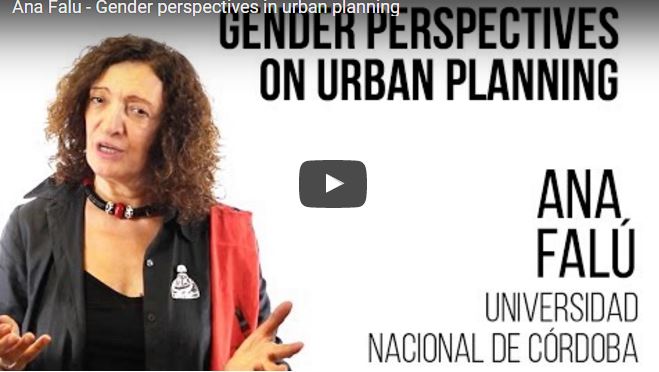
* Click here to watch the video.
This lecture aims to discuss the inclusion of women in
the debate around cities, incorporating proposals and experiences primarily
related to urban policies in Latin America.
Given the advances in the LAC
region and world-while addressing women’s rights, this lecture focuses on the
persistence of omitting women in urban planning. The lecture departs from the
assumptions that city planning and access to urban assets and their
distribution in the territory are unequal, in addition to the socio-demographic
transformations, and the need to recognize the contribution to social wellbeing
as well as the participation of women into urban economy.
The urbanization is here analyzed
from a gender perspective and women’s demands, including accessibility,
services and use of public spaces, time and space variables, cross cutting with
the right of women to live a life free of violence. The urban form and urban
economy pose a complex debate in which it is also necessary to incorporate the
analysis on the evidence of gender omission. The gender dimension and the
diversity of social individuals should be central within the debates on cities
vis a vis their transformation in the globalization process. In considering the
empirical evidence of the extension and the resulting urban form of cities that
are more elusive, fragmented, unequal and gender blind it is apparent that the
need for more data and knowledge is crucial. Inclusive planning also calls for
the promotion of a more equal accessibility to urban equipment, services and
accessibility prioritizing the collective over the individual, and considering
people in vulnerable conditions. In planning terms, it is a necessity to
challenge the current approach to planning, and the need to work on
microphysics of territories as a key for life quality.
Propositions for addressing the
issue:
1. City transformations and the
impact in women’s life. The analysis is based on Latin America, the growth of
the region and the persistency of inequities, in particular the unequal
distribution of urban assets in the territory.
2. Socio-demographic
transformation: Women’s lives in cities relate to their experiences in the
different scales where they live and act.
3. The perception of the cities
are not equal for men and women.Due to their role, women use cities in a
different way. For example public spaces should be considered in relation to
urban violence.
4. Instruments and policies to
analyze implementation of gender urban planning in cities.
BIOGRAPHY
Ana Falú is an Architect,
graduated at the National University of Tucuman, Argentina; with postgraduate
studies in The Netherlands: specialization in Bouwcentrum (1974), and a
Doktoraal in the Technical University of Delft (1985). Her field of research and
action is in Urban and Housing design and policies with a gender perspective.
She has field experience in different countries of the world, having lived and
worked in the Netherlands, Argentina, Ecuador, and Brazil. International
experience as Head of UNIFEM (today UN Women), first as head of the Andean
Region office (2002-4) and later in Brazil and Southern Cone Countries
(2004-09).
Currently Falú is the Chair,
Professor and Researcher in Architecture at the National University of
Cordoba and the Director of the INVIHAB –Research Institute on Housing and
Habitat -; serves as Gender Expert for Union Iberoamericana de Municipalistas-,
and since 2013 a member of AGGI Advisory Group for Gender Inclusion for
UN-Habitat, in 2014 she launched the Gender Hub of UNI/UN-Habitat. She is also
Professor of different postgraduate courses on Integrated Planning, Cities and
Gender, in Rome, Santiago, Buenos Aires, Barcelona, Delft, Germany, and in more
than 10 Latin American Universities. Member of Architecture Doctorate of the
National University of Cordoba.
ADDITIONAL READING MATERIAL
Falú, Ana (ed.) “Women in the
city on Violence and Rights”. Women and Habitat Network of Latin America –
Editions Sur, Chile. Printed in Chile. 2009.177pp. (7.1.14)
Aguirre,
Rosario (2009) “Uso del tiempo y desigualdades de género en el trabajo no
remunerado”, in: Rosario Aguirre (editor) Las bases invisibles del bienestar
social. El trabajo no remunerado en Uruguay. INE/ INMUJERES/ UDELAR, FCS,
DS/UNIFEM/UNFPA. Montevideo.
Boccia,
Teresa (2002). El tiempo y el Espacio de las Ciudades. La experiencia italiana.
Università degli studi di Napoli Federico II – Dipartimento di Urbanistica.
Segundo Seminario Internacional sobre Género y Urbanismo Infraestructuras para
la Vida Cotidiana ETSAM, UPM . http://www.generourban.org
Borja, Jordi
(1995). La ciudad del futuro es femenina. El País (11-8-1995)
Castells,
Manuel: La ciudad de las mujeres, en Local y Global de Borja J y Castells M,
cap IV (re edition2010) ECLAC, Gender Observatory, Chile. 2012, 2014.
Falú, Ana
(ed. 2002) Ciudades para Varones y Mujeres. Herramientas para la acción.
Impreso M y M impresiones. Cordoba, Argentina.
Falú, Ana;
Morey, Patricia and Rainero, Liliana (ed. 2002). Uso del tiempo y del espacio:
asimetrías de género y de clase, en Ciudad y Vida Cotidiana. Asimetrías en el
uso del tiempo y del espacio. Córdoba, Argentina.
Falu, Ana
(ed. 2009). Mujeres en la ciudad. De violencias y derechos. Ediciones
SUR, 1ª edición. Red Mujer y Hábitat de América Latina (2011),
Construyendo Ciudades Seguras. Experiencias de redes de Mujeres de América
Latina. Ediciones Sur. Santiago, Chile.
Women and Habitat Network LAC: www.redmujer.org.ar